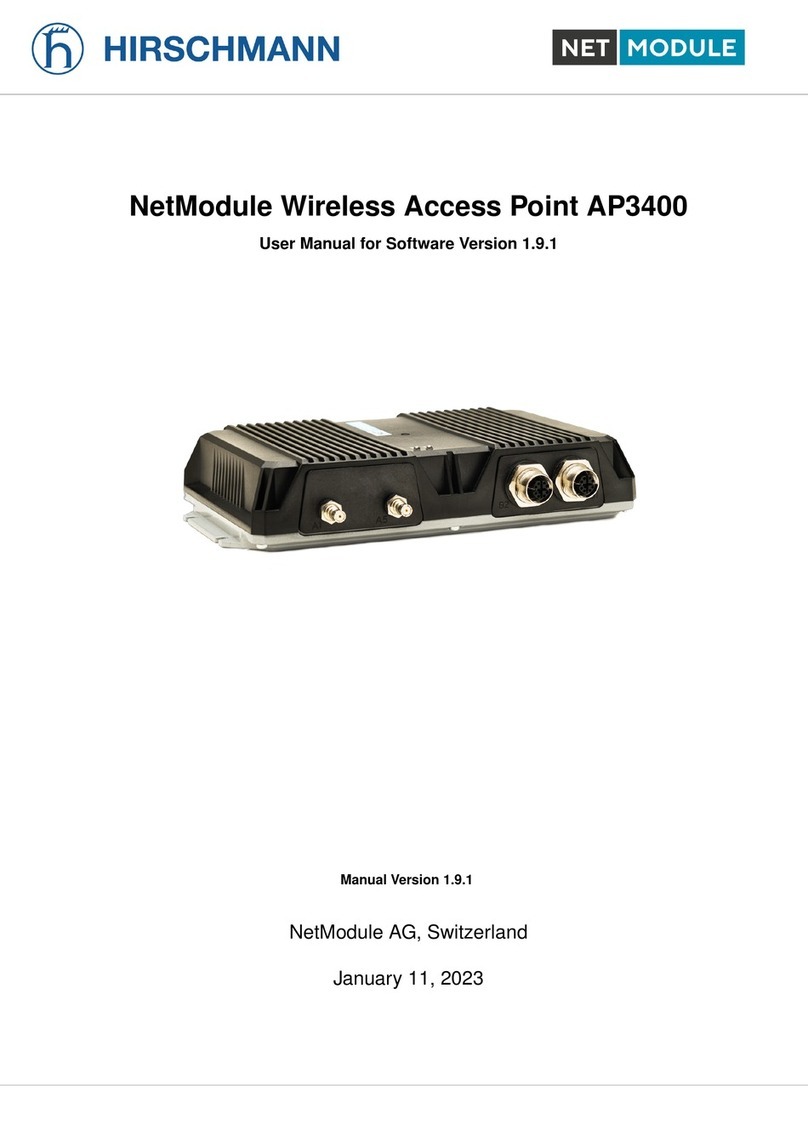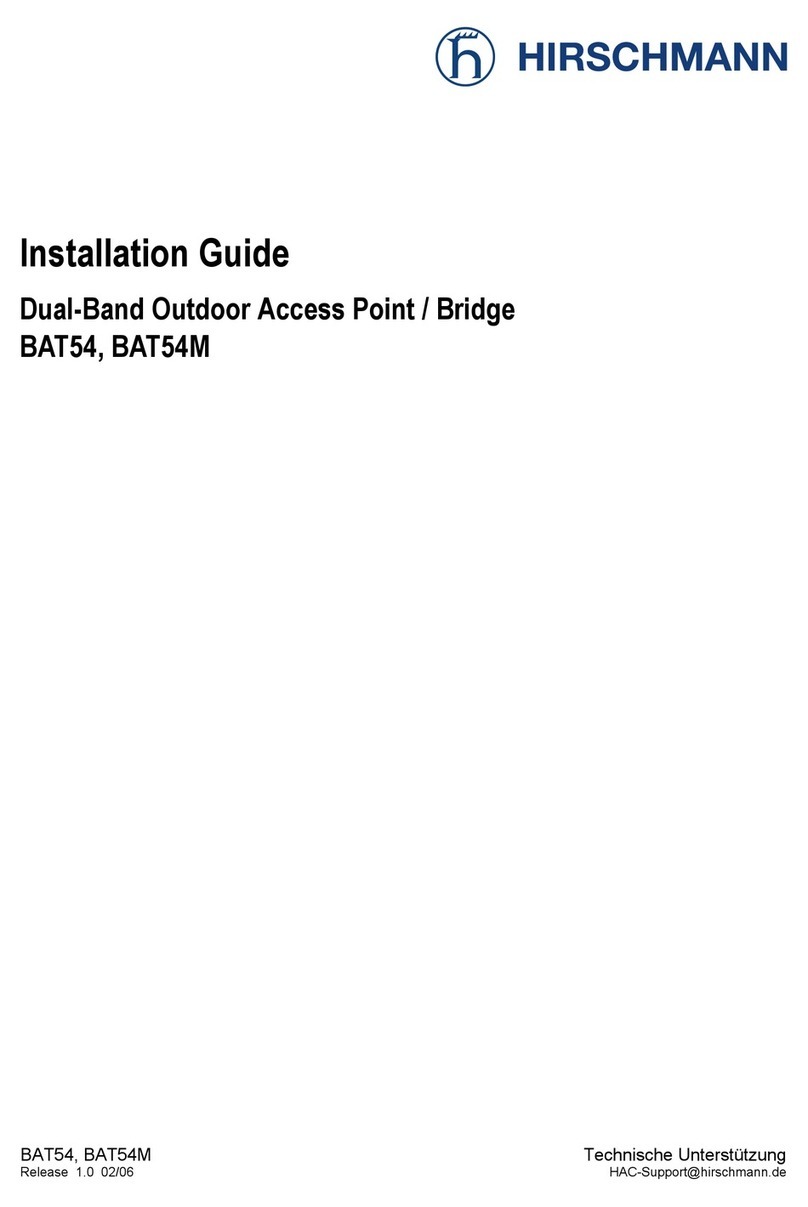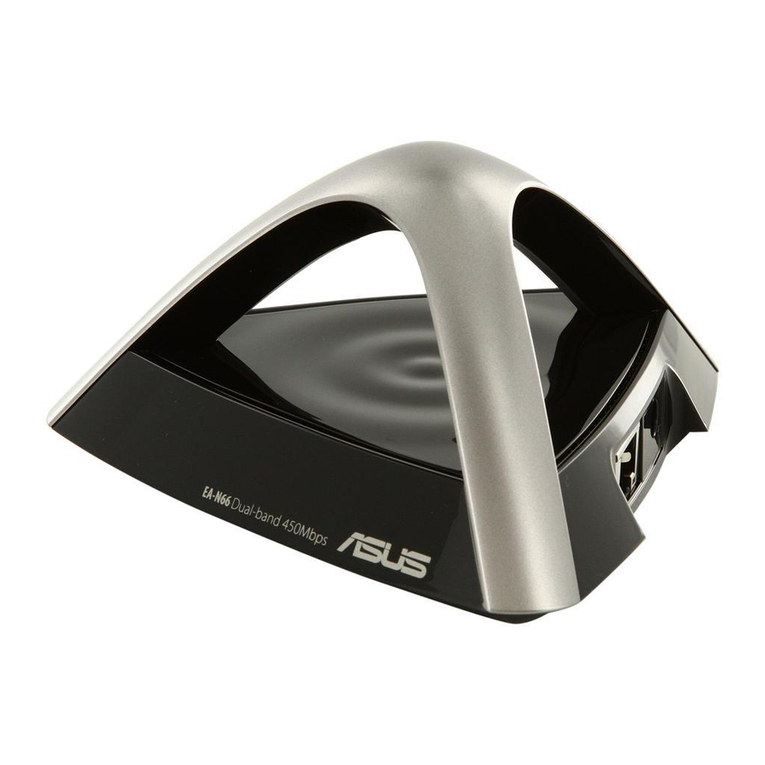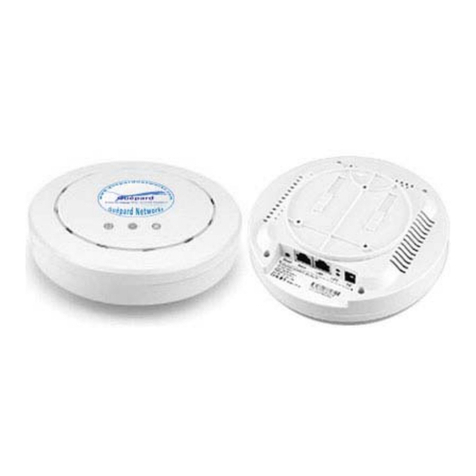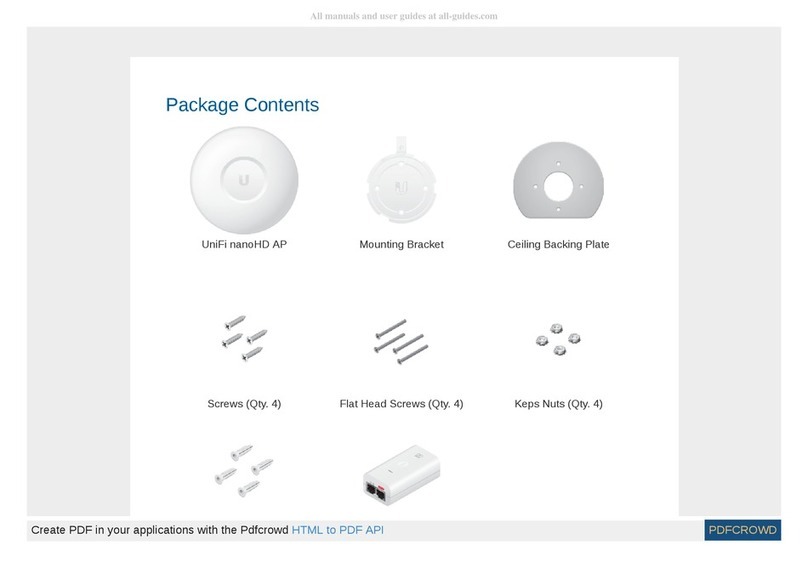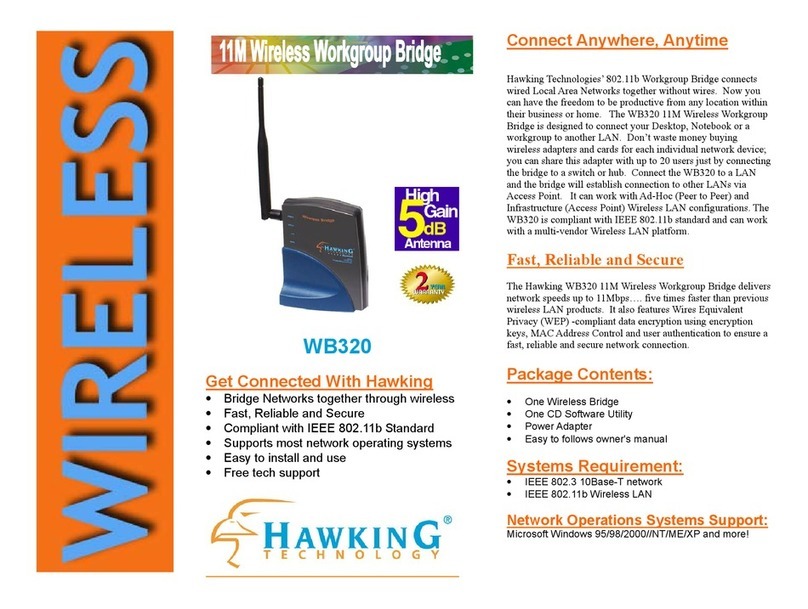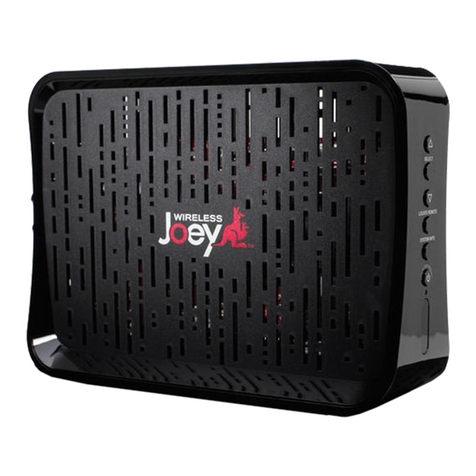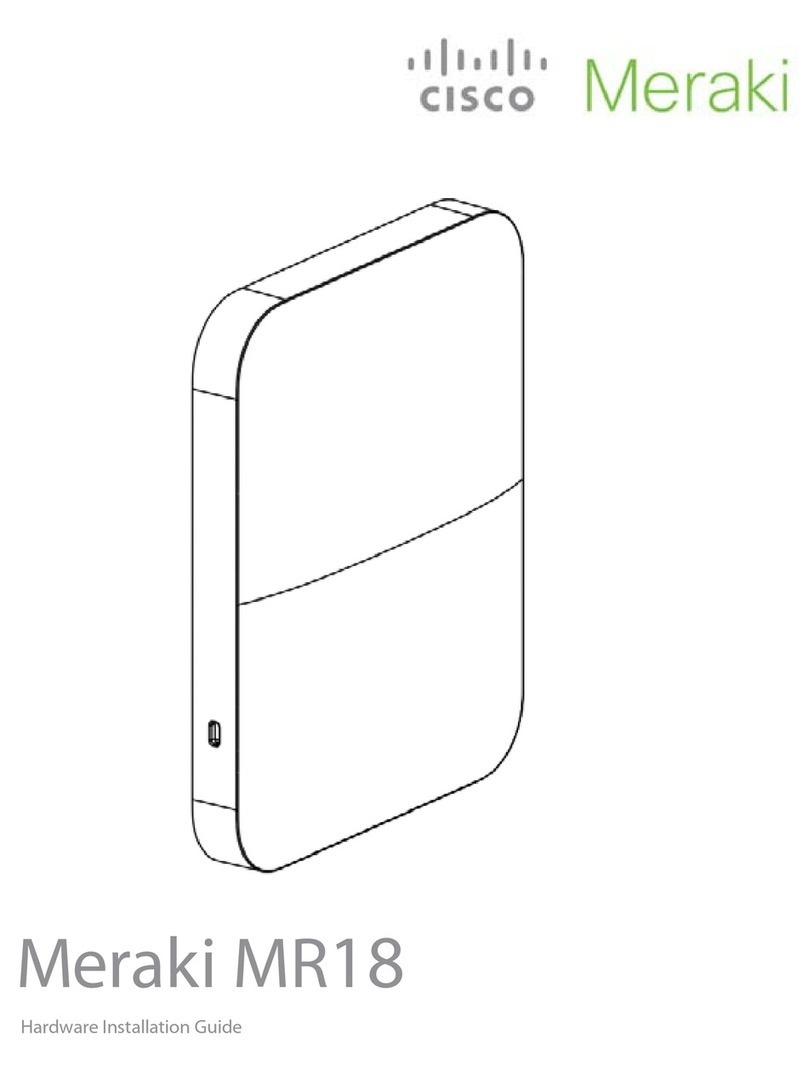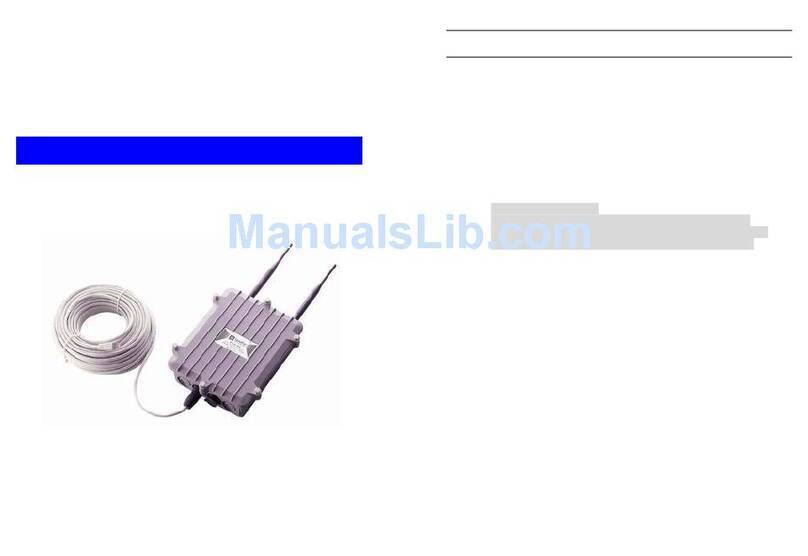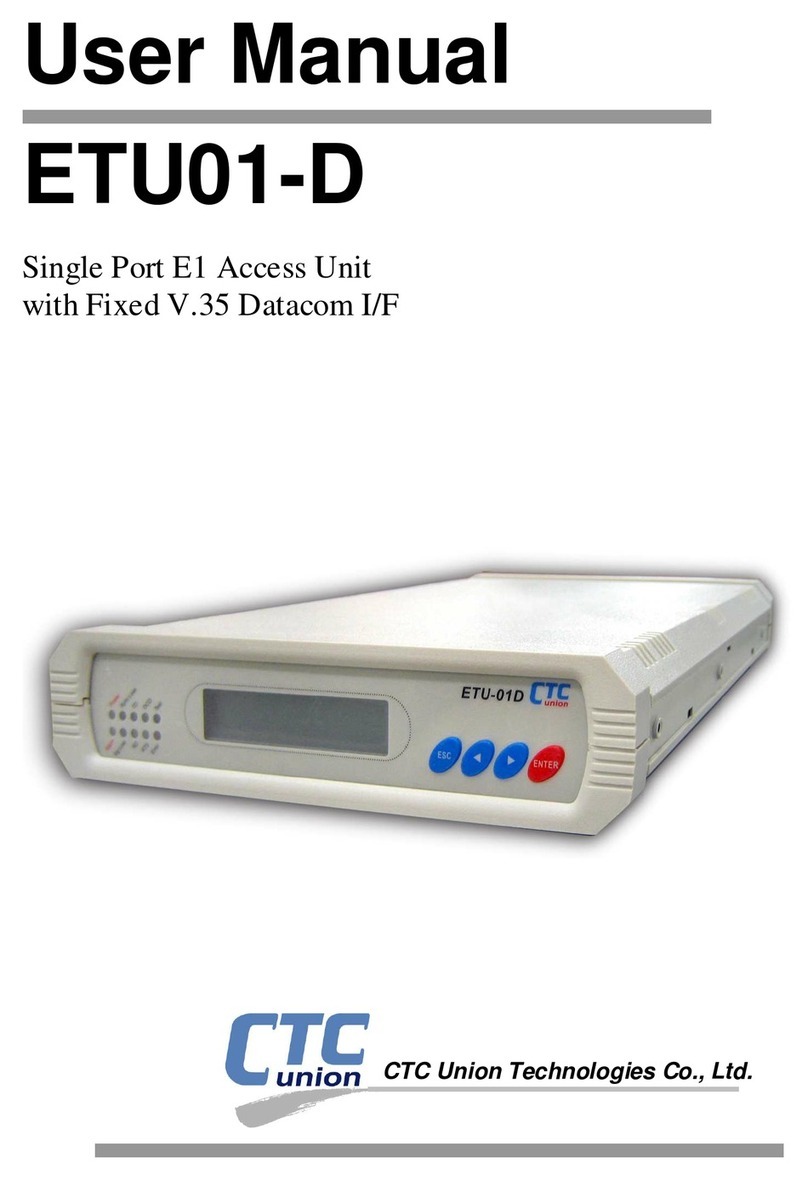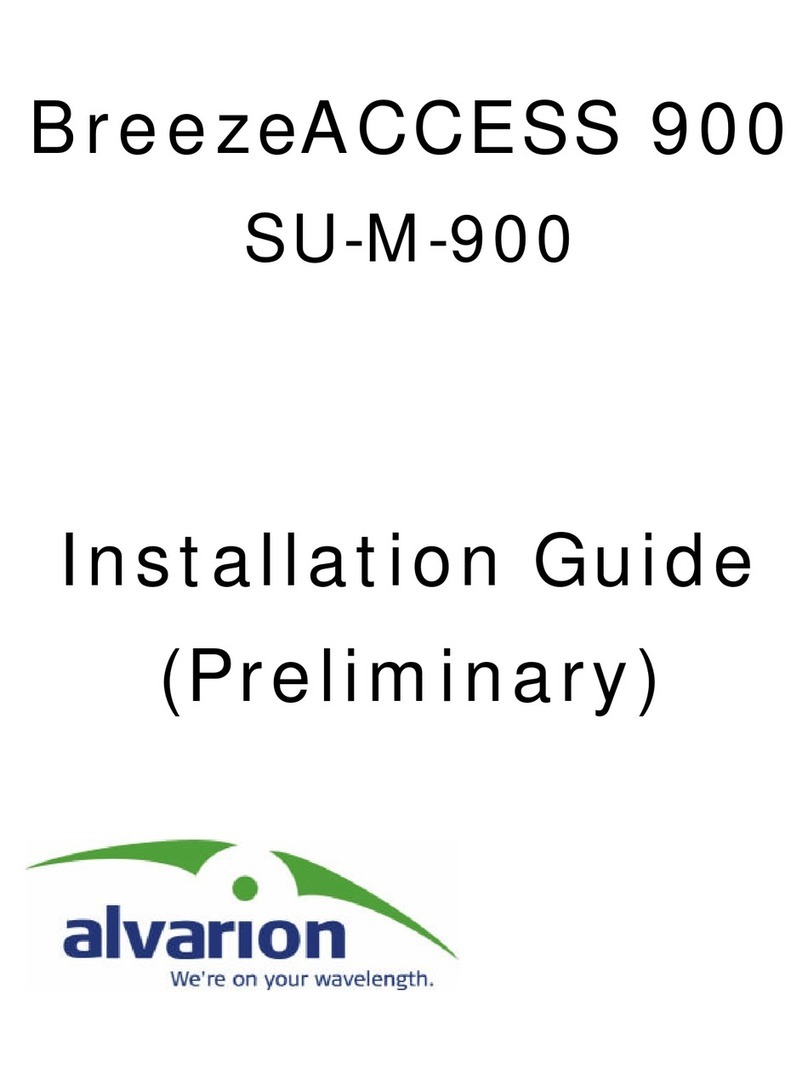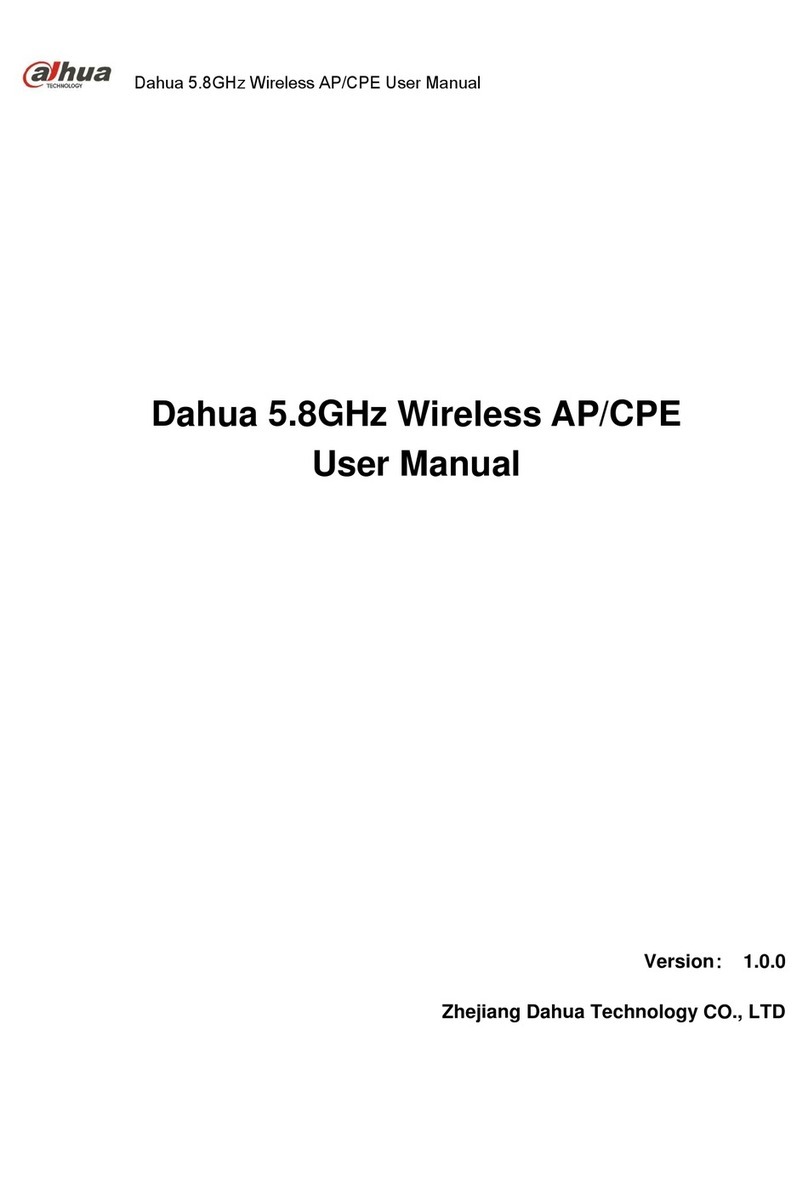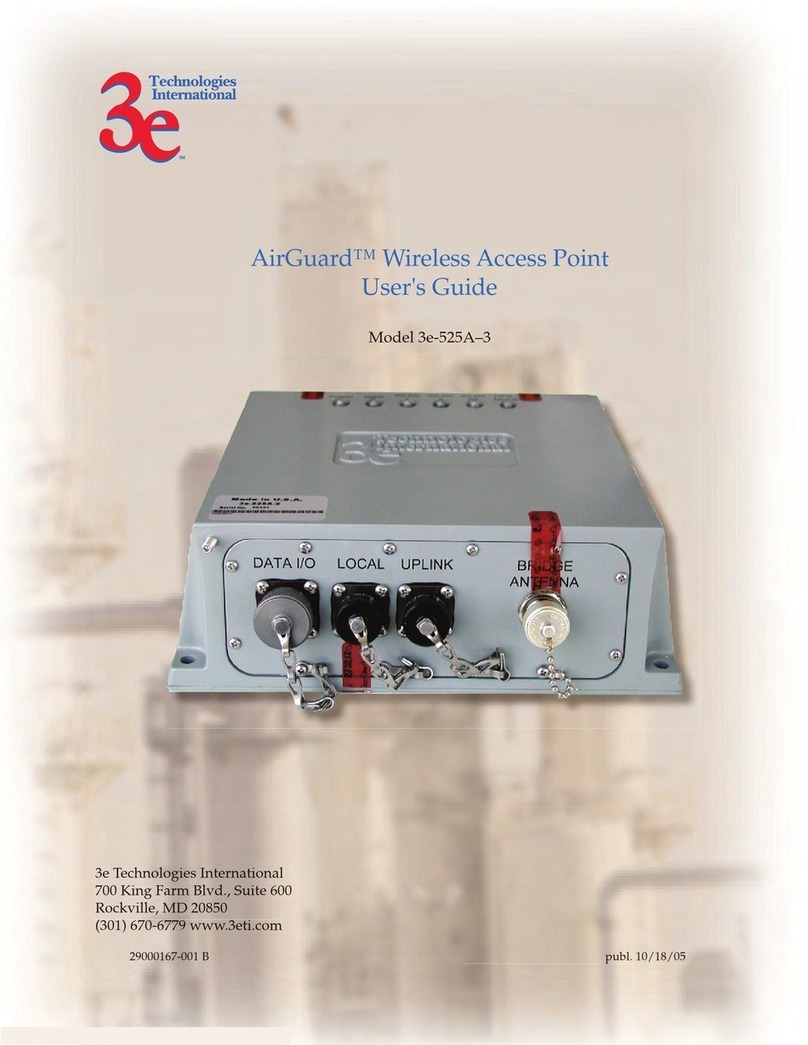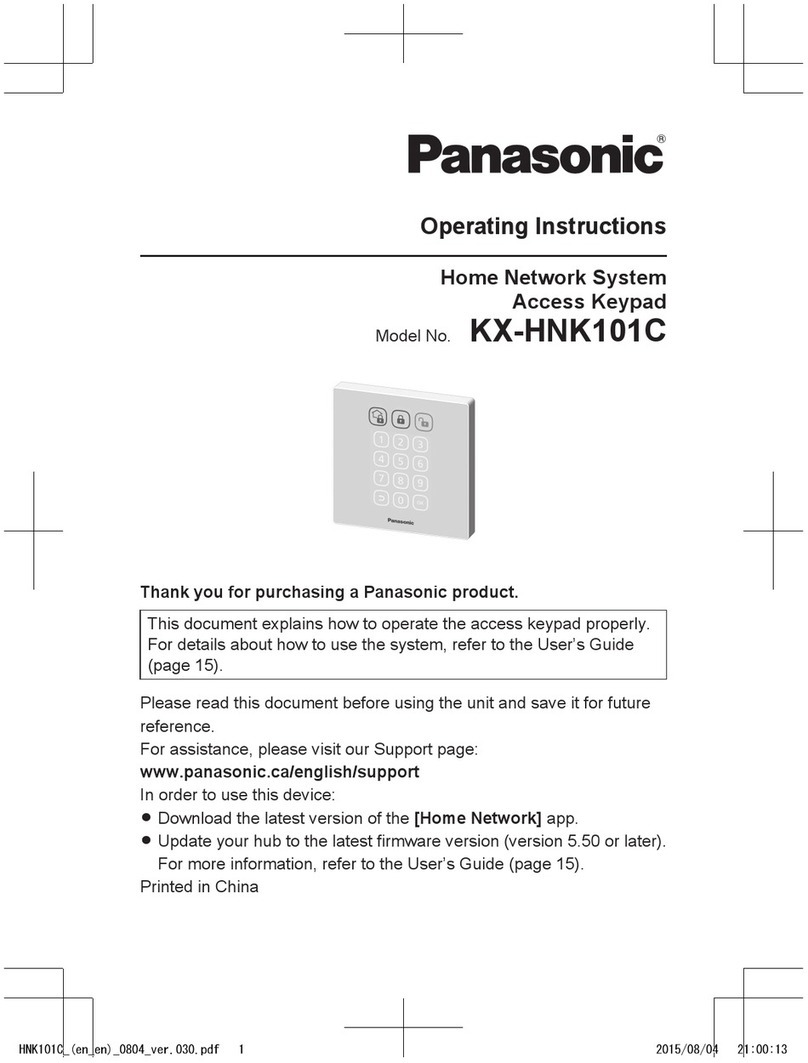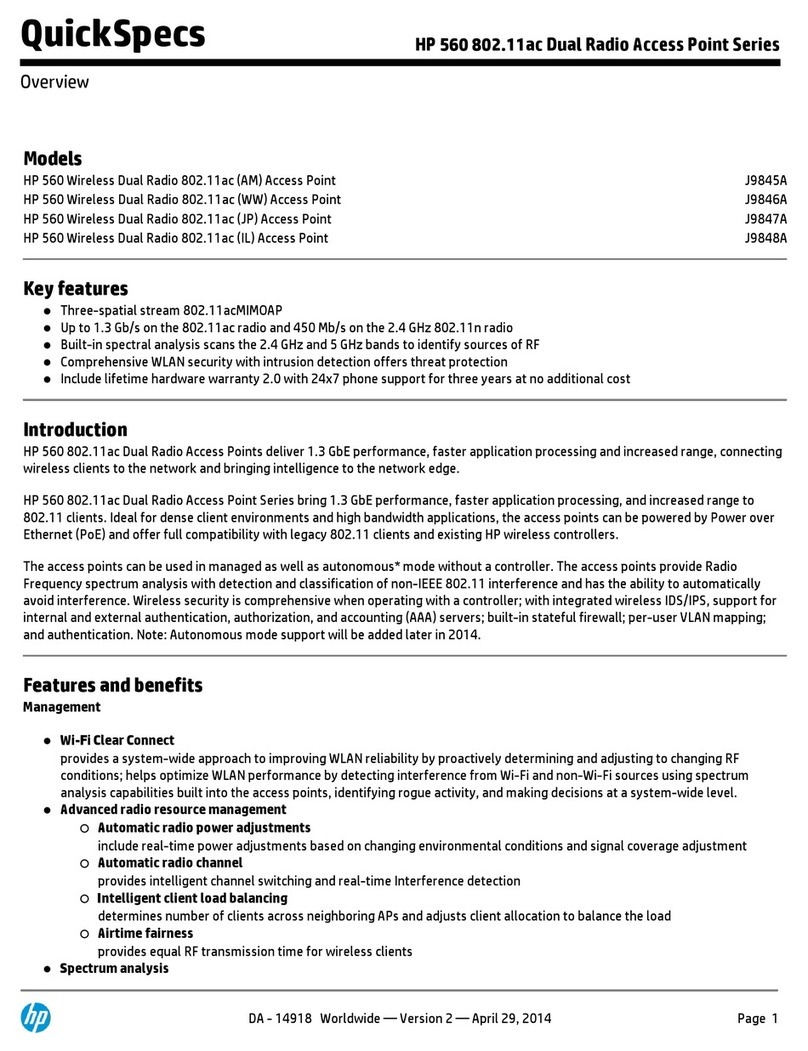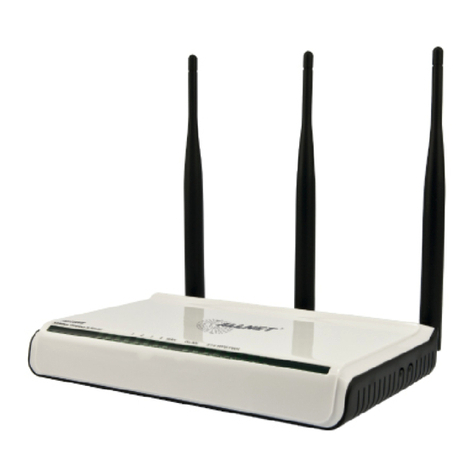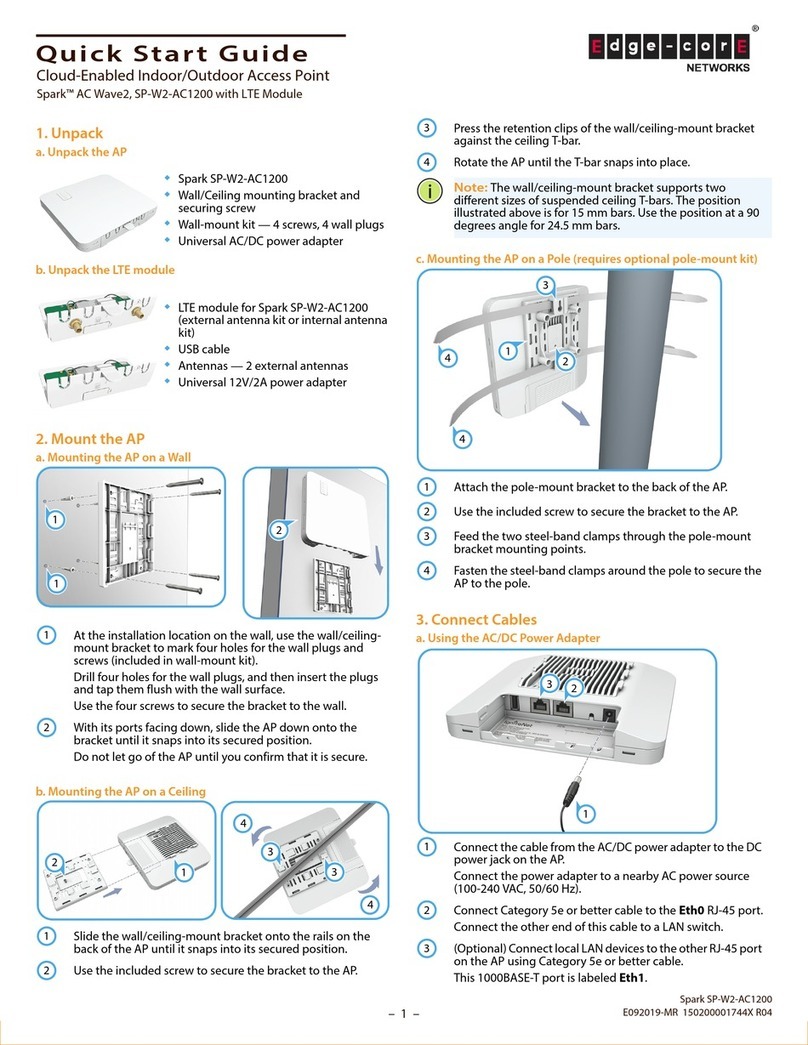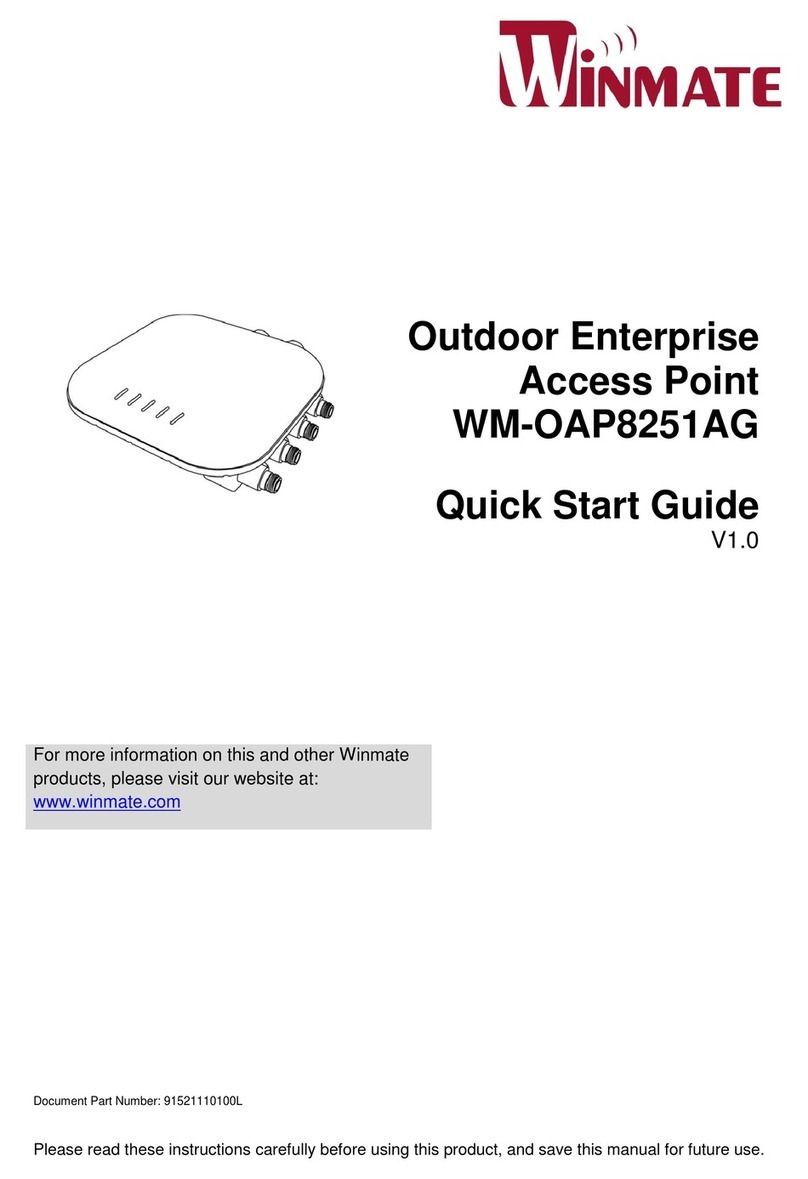Hirschmann BAT series User manual

Installation BAT
Release
05
03/2013
Technical support
https://hirschmann-support.belden.eu.com
User Manual
Installation
Dual-Band Industrial Access Point / Client / Access Bridge
BAT Family
BAT54-Rail
WLAN2
WLAN1
M1
Aux1 Aux2
BAT300-Rail
BAT54-Rail Client
AuxMain
BAT54-F
BAT54-Rail BAT300-RailBAT54-Rail Client
4
1
23
1
2
3
4
Pin
TX
RX
N.C.
GND
Function
V.24
1
2
3
4
Pin
TD+
RD+
TD-
RD-
Function
4
1
23
Ethernet
43
21
5
1
2
3
4
5
Pin
+24V DC
0 V
0 V
+24V DC
N.C.
Function
Reset Power LED
Main 1 Main 2 AUX 1 AUX 2
BAT54-F
IP67 WLAN Access Point
LS/DAP
WLAN
2
WLAN
1
Uin: 24 VDC
Uin: 48 VDC
CLASS2
CLASS2
Iin: 400 mA
Iin: 170 mA (PoE)
4
1
23
1
2
3
4
Pin
TX
RX
N.C.
GND
Function
V.24 Reset LED
Main AUX
BAT54-F Client
IP67 WLAN Access Point
Uin: 24 VDC
Uin: 48 VDC
CLASS2
CLASS2
Iin: 420 mA
Iin: 170 mA (PoE)
WLAN
1
2
3
4
Pin
TD+
RD+
TD-
RD-
Function
4
1
23
Ethernet
43
21
5
1
2
3
4
5
Pin
+24V DC
0 V
0 V
+24V DC
N.C.
Function
Power
LS/DAP
NC 4
1
23
1
2
3
4
Pin
TX
RX
N.C.
GND
Function
V.24
1
2
3
4
Pin
TD+
RD+
TD-
RD-
Function
4
1
23
Ethernet
43
21
5
1
2
3
4
5
Pin
+24V DC
0 V
0 V
+24V DC
N.C.
Function
Reset Power LED
Antenna 1 Antenna 2 Antenna 3
BAT300-F
IP67 WLAN Access Point
LS/DAP
Uin: 24 VDC
Uin: 48 VDC
CLASS2
CLASS2
Iin: 420 mA
Iin: 170 mA (PoE)
WLAN
NC
BAT54-F Single
BAT54-F Client BAT300-F
4
1
23
1
2
3
4
Pin
TX
RX
N.C.
GND
Function
V.24
1
2
3
4
Pin
TD+
RD+
TD-
RD-
Function
4
1
23
Ethernet 2
Reset LED
Main AUX
BAT54-F Single
IP67 WLAN Access Point
Uin: 24 VDC
Uin: 48 VDC
CLASS2
CLASS2
Iin: 420 mA
Iin: 170 mA (PoE)
1
2
3
4
Pin
TD+
RD+
TD-
RD-
Function
4
1
23
Ethernet 1
WLAN
PLS/DA
2
LS/DA
1
xBAT54-Rail Single
Main Aux
Reset
V.24
12V DC
+24V
0V
+24V
0V
ETH
WLAN
P
BAT54-Rail Single

The naming of copyrighted trademarks in this manual, even when not specially indicated, should
not be taken to mean that these names may be considered as free in the sense of the trademark
and tradename protection law and hence that they may be freely used by anyone.
© 2013 Hirschmann Automation and Control GmbH
Manuals and software are protected by copyright. All rights reserved. The copying, reproduction,
translation, conversion into any electronic medium or machine scannable form is not permitted,
either in whole or in part. An exception is the preparation of a backup copy of the software for
your own use. For devices with embedded software, the end-user license agreement on the
enclosed CD/DVD applies.
The performance features described here are binding only if they have been expressly agreed
when the contract was made. This document was produced by Hirschmann Automation and
Control GmbH according to the best of the company's knowledge. Hirschmann reserves the right
to change the contents of this document without prior notice. Hirschmann can give no guarantee
in respect of the correctness or accuracy of the information in this document.
Hirschmann can accept no responsibility for damages, resulting from the use of the network
components or the associated operating software. In addition, we refer to the conditions of use
specified in the license contract.
You can get the latest version of this manual on the Internet at the Hirschmann product site
(www.hirschmann.com).
Printed in Germany
Hirschmann Automation and Control GmbH
Stuttgarter Str. 45-51
72654 Neckartenzlingen
Germany
Tel.: +49 1805 141538
BAT 039 726-002-05-0313 – 06.03.2013

Installation BAT
Release
05
03/2013 3
Contents
Safety instructions 5
About this manual 14
1 Device description 15
1.1 Properties and functions 15
1.1.1 BAT-F types 16
1.1.2 BAT-Rail types 16
1.1.3 BAT54 types 16
1.1.4 BAT300 types 17
1.1.5 BAT-BG/BGN types 17
1.1.6 Other features 18
1.2 Interfaces and control elements 20
1.2.1 BAT54-F 20
1.2.2 BAT54-F Single 21
1.2.3 BAT54-F Client 22
1.2.4 BAT300-F 23
1.2.5 BAT54-Rail 24
1.2.6 BAT54-Rail Single 25
1.2.7 BAT54-Rail Client 26
1.2.8 BAT300-Rail 27
1.3 Device models 28
1.3.1 BAT54-F devices 28
1.3.2 BAT54-Rail devices 29
1.3.3 BAT300-F devices 29
1.3.4 BAT300-Rail devices 29
1.3.5 BAT-BG/BGN devices 30
2 Assembly and start-up 31
2.1 Installing the device 31
2.2 Unpacking and checking 31
2.3 Putting components together (BAT-F) 32
2.4 Selecting the location for mounting/
setting up 32
2.5 Mounting outdoors (BAT-F) 32
2.5.1 Lightning protection 32
2.5.2 Pole mounting 34
2.6 DIN rail mounting (BAT-Rail) 35
2.7 Flat surface mounting 35
2.7.1 BAT-F 35

4Installation BAT
Release
05
03/2013
2.7.2 BAT-Rail 36
2.8 Mounting/connecting external antennas 36
2.8.1 Connections for external antennas on BAT-F 36
2.8.2 Connections for external antennas on BAT-Rail 39
2.8.3 Mounting external antennas 41
2.9 Connecting LAN and WLAN connectors 42
2.9.1 BAT-F 42
2.9.2 BAT-Rail 42
2.10 Grounding 43
2.10.1 BAT-F 43
2.10.2 BAT-Rail 43
2.11 Connecting the supply voltage 44
2.11.1 5-pin M12 connector (BAT-F) 44
2.11.2 4-pin terminal block (BAT-Rail) 44
2.11.3 Power over Ethernet (PoE) -
power supply via the LAN cable 45
2.12 Connecting the data lines 46
2.12.1 10/100 Mbit/s twisted pair connection 46
2.12.2 10/100 Mbit/s twisted pair connection 48
2.13 Mounting the housing cover for BAT-F X2 49
2.14 Startup procedure 50
2.14.1 BAT-F 50
2.14.2 BAT-Rail 50
3 Technical data 62
A Further Support 69

Installation BAT
Release
05
03/2013 5
Safety instructions
Certified usage
Only use the device for application cases that are described in the
Hirschmann product information, including this manual. Only operate the
device according to the technical specifications.
Supply voltage
The devices are designed for operation with a safety extra-low voltage.
Only connect SELV circuits with voltage restrictions in line with IEC/EN
60950-1 to the supply voltage connections.
The supply voltage is electrically isolated from the housing.
Use undamaged parts.
For BAT300-Rail: Make sure that the DC power supply line has a
maximum length of 3 meters.
Relevant for North America: For use in Class 2 circuits. Only use
copper wire/conductors of class 1, 75 °C or 90 °C (167 °F or 194 °F).
Relevant for North America:
The device may only be connected to a Class 2 supply voltage that fulfills
the requirements of the National Electrical Code, Table 11(b). If the
voltage is being supplied redundantly (two different voltage sources), the
combined supply voltages must fulfill the requirements of the National
Electrical Code, Table 11(b).
Relevant for North America:
Adapters for BAT-F types providing field wiring means you obtain from
the manufacturer. For field wiring, use a type E12-AA5A1A power
supply cable, manufactured by Belden.
Shielding ground
The shield of the connectable twisted pair cables is connected to the
metal casing of the device as a conductor.
Beware of possible short circuits when connecting a cable section with
conductive shielding braiding.
Housing
Only technicians authorized by the manufacturer are permitted to open
the housing.
Warning!
Never insert sharp objects (small screwdrivers, wires, etc.) into
the inside of the product. There is the risk of an electric shock.

6Installation BAT
Release
05
03/2013
BAT-F types:
A separate screw connector on the housing is provided for the functional
ground (FE). This is indicated by the functional ground symbol ( ). The
functional ground is electrically connected to the switching ground and the
metal housing of the device.
BAT-Rail types:
The lower panel of the device housing is grounded by means of the DIN
rail.
If you are operating the device in a living area or office environment,
only operate it in switch cabinets with fire protection characteristics in
accordance with EN 60950-1.
Environment
Note:
Relevant for BAT-Rail types:
Classification for Europe: IP40 (EN 60529)
Classification for North America: Open type (NEMA).
For use in indoor locations, NFPA 70
Relevant for BAT-F types:
Classification for Europe: IP67 (EN 60529)
Classification for North America: Type 1 (NEMA - indoor use only).
For use in NFPA 79 applications only.
Note: All North America outdoor installations require the use of
approved outdoor enclosures (NEMA or equivalent).

Installation BAT
Release
05
03/2013 7
Operate the device at the specified surrounding air temperature
(temperature of the surrounding air at a distance of up to 1.97 in (5 cm)
from the device) and relative air humidity specified in the technical data.
When you are selecting the installation location, make sure you
observe the climatic threshold values specified in the technical data.
Use the device in an environment within the pollution degree specified
in the technical data.
Note:
Relevant for BAT-Rail types: Environmental rating: open type
For use in ordinary locations, NFPA 70.
Relevant for BAT-F types: Environmental rating: Type 1 (indoor use only).
For use in NFPA 79 applications only.
When installing external antennas, adhere to the regulations of the
country in which you are operating the WLAN device.
In ambient temperatures under -10 °C, use cabling designed for
minimum temperatures.
Relevant for use in Ex zone 2 according to ATEX 95 (ATEX 100a):
Only products labeled accordingly may be operated in Ex zone 2.
When operating the BAT-300F X2 types in Ex zone 2, the following
applies:
II 3G
Ex nA IIC T4 Gc, -20 °C ... +55 °C
KEMA 10ATEX0124 X
DO NOT OPEN WHEN ENERGIZED.
When operating the BAT-54F X2 types in Ex zone 2, the following applies:
II 3G
Ex nA IIC T4 Gc, -20 °C ... +60 °C
KEMA 07ATEX0190
DO NOT OPEN WHEN ENERGIZED.
The BAT-300/54F X2 types are installed with a housing cover - as
mounted in the state on delivery.
Temperature Code T4 Ambient -20 °C … +55 °C
List of Standards EN 60079-0: 2009
EN 60079-15: 2010
Temperature Code T4 Ambient -20 °C … +60 °C
List of Standards EN 60079-0: 2009
EN 60079-15: 2010

8Installation BAT
Release
05
03/2013
When operating the BAT54/300-Rail types in Ex zone 2, the following
applies:
II 3G
Ex nA IIC T4 Gc, -30 °C ... +50 °C
DEKRA 11ATEX0007 X
DO NOT OPEN WHEN ENERGIZED.
DO NOT USE THE 12 VDC INPUT, WHEN OPERATING THE DEVICE
IN HAZARDOUS LOCATIONS.
Relevant for use in Hazardous Locations (Class 1 Division 2):
Only products labeled accordingly may be operated in Class 1 Division 2
Hazardous Locations.
When operating the BAT54/300-Rail FCC types in Class 1 Division 2
Hazardous Locations, the following applies:
CLASS I; DIV. 2
GROUPS A; B; C AND D
TEMPERATURE CODE T4
AMBIENT -30 °C ... +50 °C
List of Standards: FM3600, FM3611
DO NOT OPEN WHEN ENERGIZED.
DO NOT USE THE 12 VDC INPUT, WHEN OPERATING THE
DEVICE IN HAZARDOUS LOCATIONS.
Special conditions for safe use
Provisions shall be made to prevent the rated voltage from being
exceeded by transient disturbances of more than 40 %.
When the temperature under rated conditions exceeds 70 °C at the
cable or conduit entry point, or 80 °C at the branching point of the
conductors, the temperature specification of the selected cable shall
be in compliance with the actual measured temperature values.
Temperature Code T4 Ambient -30 °C … +50 °C
List of Standards EN 60079-0: 2009
EN 60079-15: 2010

Installation BAT
Release
05
03/2013 9
Lightning protection
When you mount devices and / or antennas outdoors, there is a risk of
them being struck by lightning. Additionally, there is the risk of voltage
surges being transmitted into the interior of the building. It is your
responsibility to take appropriate measures to mitigate the effects of
lightning strikes. Make sure the equipment is installed by a licensed
electrician in accordance with local, regional and national regulations for
codes and standards (such as VDE 0182 and IEC 62305) and according
to best practices for your application and environment.
Warning
When you mount devices outside buildings, there is a risk of
them being struck by lightning. Additionally, there is the danger
of voltage strikes being transmitted into the interior of the
building.
See the information in the “WLAN Outdoor Guide”, chapter “Lightning
and Surge Voltage Protection”.
Make sure that your plant designer or installer has carried out suitable
lightning prevention measures.
Qualification requirements for personnel
Qualified personnel as understood in this manual and the warning signs,
are persons who are familiar with the setup, assembly, startup, and
operation of this product and are appropriately qualified for their job. This
includes, for example, those persons who have been:
trained or directed or authorized to switch on and off, to ground and to
label power circuits and devices or systems in accordance with current
safety engineering standards;
trained or directed in the care and use of appropriate safety equipment
in accordance with the current standards of safety engineering;
trained in providing first aid.
General safety instructions
This device is operated by electricity. You must follow precisely the
prescribed safety requirements for the voltage connections in this
document.
See “Supply voltage” on page 5.

10 Installation BAT
Release
05
03/2013
Non-observance of these safety instructions can cause material damage
and/or injuries.
Only appropriately qualified personnel should work on this device or in
its vicinity. The personnel must be thoroughly familiar with all the
warnings and maintenance procedures outlined in this operating
manual.
The proper and safe operation of this device depends on proper
handling during transportation, proper storage and assembly, and
conscientious operation and maintenance procedures.
Never start operation with damaged components.
Only use the devices in accordance with this manual. In particular,
observe all warnings and safety-related information.
Any work that may be required on the electrical installation may only
be carried out by personnel trained for this purpose.
National and international safety regulations
Make sure that the electrical installation meets local or nationally
applicable safety regulations.
When installing external antennas, adhere to the regulations of the
country in which you are operating the WLAN device.
CE marking
The labeled devices comply with the regulations contained in the following
European directive(s):
1999/5/EC (R&TTE)
Directive of the European Parliament and the council for radio
installations and telecommunication systems and for the mutual
recognition of their conformity.
This directive also contains the goals of directive 2004/108/EC of the
European Parliament and the council for standardizing the regulations of
member states relating to electromagnetic compatibility, and directive
2006/95/EC of the European Parliament and the council for standardizing
the regulations of member states relating to electrical equipment to be
used within specific voltage ranges, but without applying the lower voltage
threshold.
This product may be operated in all EU (European Union)
countries under the condition that it has been configured correctly.
2011/65/EU (RoHS)
Directive of the European Parliament and of the Council on the restriction
of the use of certain hazardous substances in electrical and electronic
equipment.

Installation BAT
Release
05
03/2013 11
2006/95/EC
Directive of the European Parliament and the council for standardizing the
regulations of member states with regard to electrical equipment to be
used within specific voltage ranges.
2004/108/EG (EMV)
Directive of the European Parliament and the council for standardizing the
regulations of member states with regard to electromagnetic
compatibility.
In accordance with the above-named EU directive(s), the EU conformity
declaration will be at the disposal of the relevant authorities at the
following address:
Hirschmann Automation and Control GmbH
Stuttgarter Str. 45-51
72654 Neckartenzlingen
Germany
Tel.: +49 1805 141538
The product can be used in living areas (living area, place of business,
small business) and in industrial areas.
Information on using devices in motor vehicles (e1)
Some variants of the devices are e1-certified. Only operate suitably
labeled products in motor vehicles.
Note: To fulfill the requirements of directive 1999/5/EG (R&TTE
directive) when operating the device in a motor vehicle:
Supply the voltage to the device via a Power-over-Ethernet (PoE)
switch or via a power
unit that conforms to IEEE 802.3af.
You will find information on Hirschmann PoE-capable switches under
http://www.hirschmann.com.
Or:
Install an upstream filter on the 24V DC voltage supply. You will find
information on suitable filters under
http://www.hirschmann.com.
Tip: If you are using an e1-certified device in a vehicle and want to be able
to drive the vehicle freely within the EU, set the country profile for
Germany. This country profile is identical to all the country profiles for EU
countries. Just be sure not to use any special frequencies, such as
BFWA.

12 Installation BAT
Release
05
03/2013
FCC note:
This device complies with part 15 of the FCC rules.
Operation is subject to the following two conditions:
This device may not cause harmful interference, and
This device must accept any interference received, including
interference that may cause undesired operation.
Note: This equipment has been tested and found to comply with the limits
for a Class B digital device, pursuant to part 15 of the FCC Rules. These
limits are designed to provide reasonable protection against harmful
interference in a residential installation. This equipment generates, uses
and can radiate radio frequency energy and, if not installed and used in
accordance with the instructions, may cause harmful interference to radio
communications. However, there is no guarantee that interference will not
occur in a particular installation. If this equipment does cause harmful
interference to radio or television reception, which can be determined by
turning the equipment off and on, the user is encouraged to try to correct
the interference by one or more of the following measures:
Reorient or relocate the receiving antenna.
Increase the separation between the equipment and receiver.
Connect the equipment into an outlet on a circuit different from that to
which the receiver is connected.
Consult the dealer or an experienced radio/TV technician for help.
Important note:
This equipment complies with FCC and IC RSS-102 radiation exposure
limits set forth for an uncontrolled environment. This equipment should be
installed and operated with minimum distance 50 cm (19.7 in, applied to
a 23 dBi antenna) between the radiator and your body.
The antenna used for this transmitter must not be co-located with any
other transmitters within a host device, except in accordance with FCC
multi-transmitter product procedures.
This transmitter is restricted to indoor use only within the 5.15-5.25 GHz
band to reduce potential for harmful interference to co-channel mobile
satellite systems.
Note: The following paragraph is valid for the BAT300-…FCC devices
only:
The usage of the antennas BAT-ANT-N-9A-DS-IP65 and BAT-ANT-N-
MiMo5-9N-IP65 in the 5.15 - 5.25 GHz band is only permitted with an
attenuation of 3dB between antenna ports of the main unit and antenna.
Attenuation may be realized by a low loss cable such as Hirschmann
BAT-CLB-2N m-f (Order Number: 943 903-514).

Installation BAT
Release
05
03/2013 13
This Class B digital apparatus complies with Canadian ICES-003.
Cet appareil numérique de la classe B est conforme à la norme NMB-003
du Canada.
To reduce potential radio interference to other users, the antenna type
and its gain should be so chosen that the equivalent isotropically radiated
power (EIRP) is not more than that permitted for successful
communication.
This device has been designed to operate with the antennas listed below
in point-to-multipoint systems, and having a maximum gain of 9 dBi:
The antennas listed below have been designed for use exclusively in fixed
point-to-point systems operating in the 5725-5850 MHz band:
Antennas not included in this list are strictly prohibited for use with this
device. The required antenna impedance is 50 ohms.
Recycling note
After usage, this device must be disposed of properly as electronic waste,
in accordance with the current disposal regulations of your county, state,
and country.
Device model Antennas operating with this device model
BAT54-… (FCC) BAT-ANT-N-5A-IP65
BAT-ANT-N-6G-IP65
BAT-ANT-N-6ABG-IP65
BAT-ANT-N-8G-DS-IP65
BAT-ANT-N-9A-DS-IP65
BAT-ANT-N14G-IP23
BAT-ANT-N-LC-G-50m-IP65
BAT-ANT-N-LC-G-100m-IP65
BAT300-… (FCC) BAT-ANT-N-8G-DS-IP65
BAT-ANT-N-9A-DS-IP65,
BAT-ANT-N-MiMoDB-5N-IP65
BAT-ANT-N-MiMo5-9N-IP65
Table 1: Antennas for use in point-to-multipoint systems
Device model Antennas operating with this device model
BAT54-… (FCC) BAT-ANT-N-18A-V-IP65
BAT-ANT-N-23A-V-IP65
BAT-ANT-N-23A-VH-IP65
BAT300-… (FCC) BAT-ANT-N-23A-VH-IP65
Table 2: Antennas for use in fixed point-to-point systems

14 Installation BAT
Release
05
03/2013
About this manual
The “Installation” user manual contains a device description, safety
instructions, a description of the display, and the other information that you
need to install the device.
The following manuals are available as PDF files on the CD/DVD supplied:
"Installation" user manual
Reference Manual
Legend
The symbols used in this manual have the following meanings:
Listing
Work step
Subheading

Installation BAT
Release
05
03/2013 15
1 Device description
1.1 Properties and functions
The devices allow you to set up WLANs (Wireless Local Area Networks) in a
local network. In contrast to a conventional network connection via copper
cables and glass fibers, some of the communication is performed by means
of a radio link.
The devices allow you to install a new LAN or expand an existing LAN.
Thanks to their high level of flexibility, you can combine large, small, mobile
and non-mobile locations. Anywhere that high bandwidths, stable operation
and network security is required, wireless LAN with these devices provides
the ideal solution.
The BAT54-F is an access point/client with a WLAN interface for dualband
operation in accordance with IEEE 802.11b/g and IEEE 802.11a/h, and it is
specially designed for outdoor use with protection class IP67. The BAT54-F
can be installed quickly and easily using wizards via the Windows
configuration software or the Web interface. The wide range of BAT
antennas provide the correct solution for every requirement - even out-of-the-
box solutions.
The devices are designed for the special requirements of industrial
automation. They are suitable for outdoor use and in environments with the
danger of explosions. They meet the relevant industry standards, provide
very high operational reliability, even under extreme conditions, and also
long-term reliability and flexibility. The devices operate without fans and have
a redundant voltage supply. You can mount the devices on a pole or on a flat
surface (e.g. wall).

16 Installation BAT
Release
05
03/2013
The devices differ with regard to their design, the standards they support and
their certifications, as shown in the table below:
1.1.1 BAT-F types
The BAT-F devices have protection class IP67. The devices are particularly
suitable for field use. You can mount the devices on a pole or on a flat surface
(e.g. wall).
BAT-X2 types
BAT-X2 devices are suitable for use in environments with the danger of
explosions (Ex zone 2 areas according to ATEX 95 / ATEX 100a).
1.1.2 BAT-Rail types
BAT-Rail devices are suitable for use on DIN rails and on machines in the
production area, as well as on vehicles. You can snap them quickly and
simply onto the DIN rail or mount them on a flat surface (e.g. wall). With 5-
way redundant voltage supply (4-way for the BAT-Client) and a vibration-
resistant metal housing, the devices provide high operational reliability.
1.1.3 BAT54 types
The BAT54 is a dual-band industrial wireless LAN access point/client with
two independent WLAN modules in accordance with IEEE 802.11a/b/g/h and
IEEE 802.11i. In particular, the devices support the security mechanisms,
authentication procedures and data encryptions defined in the IEEE 802.11i
standard.
Design
Indoor
BAT-Rail types
Outdoor
BAT-F types
Radio standards
801.11 a/b/g/h/i
BAT54 types
Ex range
BAT X2 types
BAT54-Rail
BAT54-Rail-Client
BAT54-Rail Single
BAT54-F
BAT54-F Single
BAT54-F Client
BAT54-F X2
BAT54-F Single X2
BAT54-F Client X2
802.11 a/b/g/h/i/n
BAT300 types
BAT300-Rail BAT300-F BAT300-F X2
Table 3: Range of applications for BAT device types

Installation BAT
Release
05
03/2013 17
1.1.4 BAT300 types
The BAT300 is a dual-band industrial high-performance wireless LAN
access point/client in accordance with IEEE 802.11a/b/g/h and 802.11n. The
devices provide a higher radio output with a bandwidth of up to 300 Mbit/s.
They support MIMO (Multiple Input Multiple Output) and Multipath. The
bandwidth is increased by using the multipath transmission by means of
reflections. Three antennas for sending and receiving ensure more stable
network coverage with fewer shadow areas (see following figure).
Figure 1: Schematic representation of MIMO (Multiple Input Multiple Output)
1.1.5 BAT-BG/BGN types
BAT-BG/BGN devices only support the use of the
2.4 GHz ISM wave band.
Note: Note that the function descriptions for the BAT-BG/BGN devices in this
installation guide and in the user manuals for the devices only apply to
operation with 2.4 GHz.
Hirschmann supports you by providing country profiles. These profiles help
you to conform to the requirements of the country in which you are operating
the WLAN installation.
Make sure you always set the correct country profile.
BAT300-Rail

18 Installation BAT
Release
05
03/2013
1.1.6 Other features
Features can be managed via a Web browser, via Telnet, with a
management software product (such as Industrial HiVision or
LANconfig/LANmonitor) or locally on the device (V.24 interface).
The devices provide high mobility combined with maximum security.
The devices provide you with a large range of features:
Sturdy metal housing with protection class IP67 (BAT-F) or
protection class IP40 (BAT-Rail)
Secure mounting on a flat surface (e.g. wall), a pole (BAT-F) or a DIN rail
(BAT-Rail)
Redundant power supply with two 24 V supplies, Power over Ethernet,
and one 12 V supply
Temperature range –30 °C to +55 °C
Wireless LAN interfaces in accordance with IEEE 802.11b/g and
IEEE 802.11a/h or IEEE 802.11n
Creation of redundant WLAN connections for secure data transmission
Maximum security, also for point-to-point with encryption in accordance
with the IEEE 802.11i standard
RS-232 serial interface for configuration, remote access and the provision
of a serial gateway
Radio modules can be operated separately as an access point or client
(apart from BAT-Client types)
Fast and reliable roaming and prioritizing, also with IEEE 802.1x
authentication
High performance operating system with a wide range of functions via
MultiSSID, VLAN, Rapid Spanning Tree, RADIUS server, IP router,
firewall, DHCP server, etc.
Management software for Windows, Web configuration, Telnet interface
and management via SNMP
Antenna technology for a high quality signal
For operation indoors and outdoors
Mounting with cables provided
Secure wall and pole bracket
Optimized distribution and performance for every application
Long transmission distances
Designed for 2.4 GHz and 5 GHz wave bands

Installation BAT
Release
05
03/2013 19
Cross-platform WLAN management
A standardized, cross-platform management system for transparent
and efficient network monitoring (SNMP)
Windows management suite: LANconfig, LANmonitor, WLANmonitor
Direct management via Web browser (HTTP, HTTPS)
Command line level: TelNet
Can always be reached via serial interface
Complete and partial configuration of multiple devices via scripting
WLANmonitor for convenient monitoring of WLANs with Rogue AP
Detection
Monitoring of all BAT family devices as clients and as access points in
an application
Communication via all levels
The addition, to the BAT wireless transmission system, of the
RS20/RS30/RS40 open rail range of switches, the MICE range of
switches, the MACH range of backbone switches, and the EAGLE
security system, provides continuous communication across all levels of
the company.

20 Installation BAT
Release
05
03/2013
1.2 Interfaces and control elements
1.2.1 BAT54-F
The device is equipped with the following connectors and operation
elements:
Interfaces and display and control elements
1 V.24 Serial interface, 4-pin M12 socket with A coding, data rate min. 19.2 kbit/s, max.
115 kbit/s, connector for serial configuration cable
2 Reset Reset button behind a removable IP67 cap
restarts the device or resets the configuration
3 Ethernet Ethernet port:
4-pin M12 socket with D coding, 10/100BASE-TX, Autosensing, Power over
Ethernet (PoE), automatic MDI/MDIX recognition (no crossover cable required)
4 Power Power supply connector for safety extra-low voltage (SELV/PELV), 5-pin M12
plug
5 LED 4 display elements (power, LS/DA, WLAN1, WLAN2)
6 AUX 2 Auxiliary connector for the second WLAN module for connecting external
antennas
7 AUX 1 Auxiliary connector for the first WLAN module for connecting external antennas
8 Main 2 Main connector for the second WLAN module for connecting external antennas
9 Main 1 Main connector for the first WLAN module for connecting external antennas
9 8 7 6
31 42 5 5
4
1
23
1
2
3
4
Pin
TX
RX
N.C.
GND
Function
V.24
1
2
3
4
Pin
TD+
RD+
TD-
RD-
Function
4
1
23
Ethernet
43
21
5
1
2
3
4
5
Pin
+24V DC
0 V
0 V
+24V DC
N.C.
Function
Reset Power LED
Main 1 Main 2 AUX 1 AUX 2
BAT54-F
IP67 WLAN Access Point
LS/DAP
WLAN
2
WLAN
1
Uin : 24 VDC
Uin : 48 VDC
CLASS 2
CLASS 2
Iin : 400 mA
Iin : 170 mA (PoE)
BAT54-F
LS/DAPower
WLAN
2
WLAN
1
This manual suits for next models
8
Table of contents
Other Hirschmann Wireless Access Point manuals
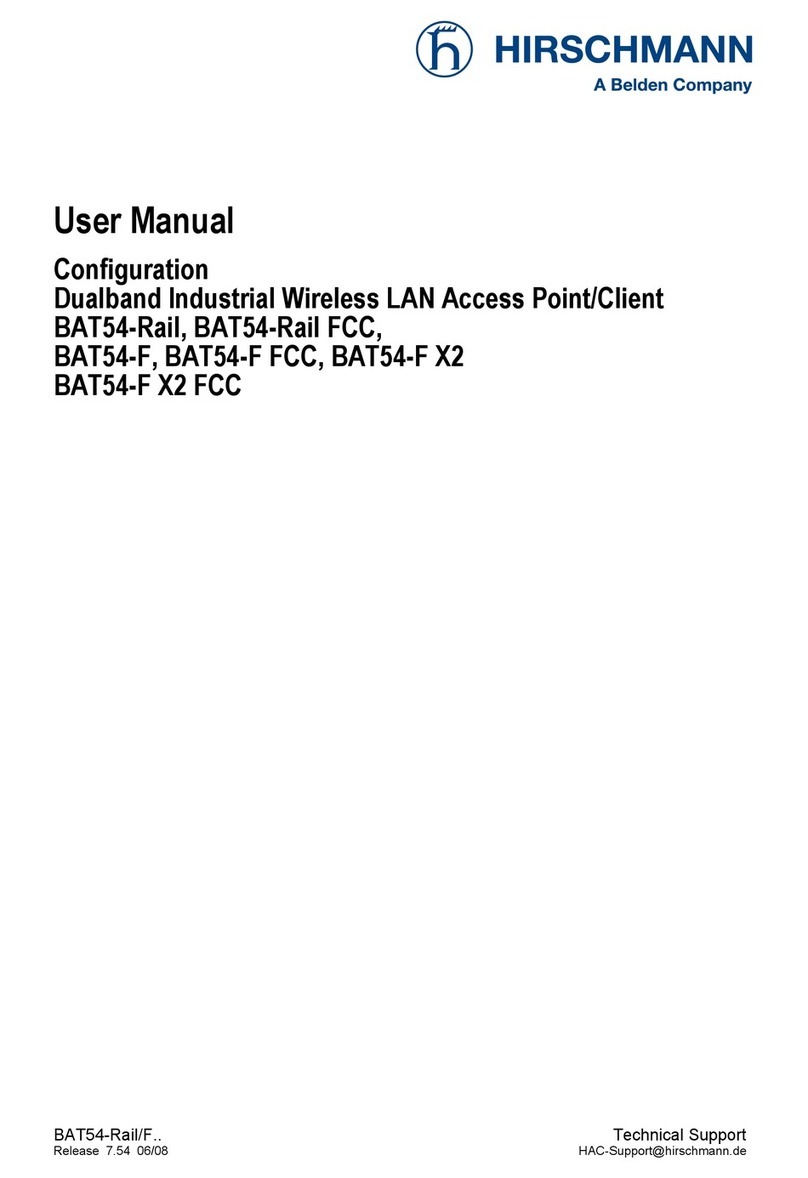
Hirschmann
Hirschmann BAT54-Rail User manual
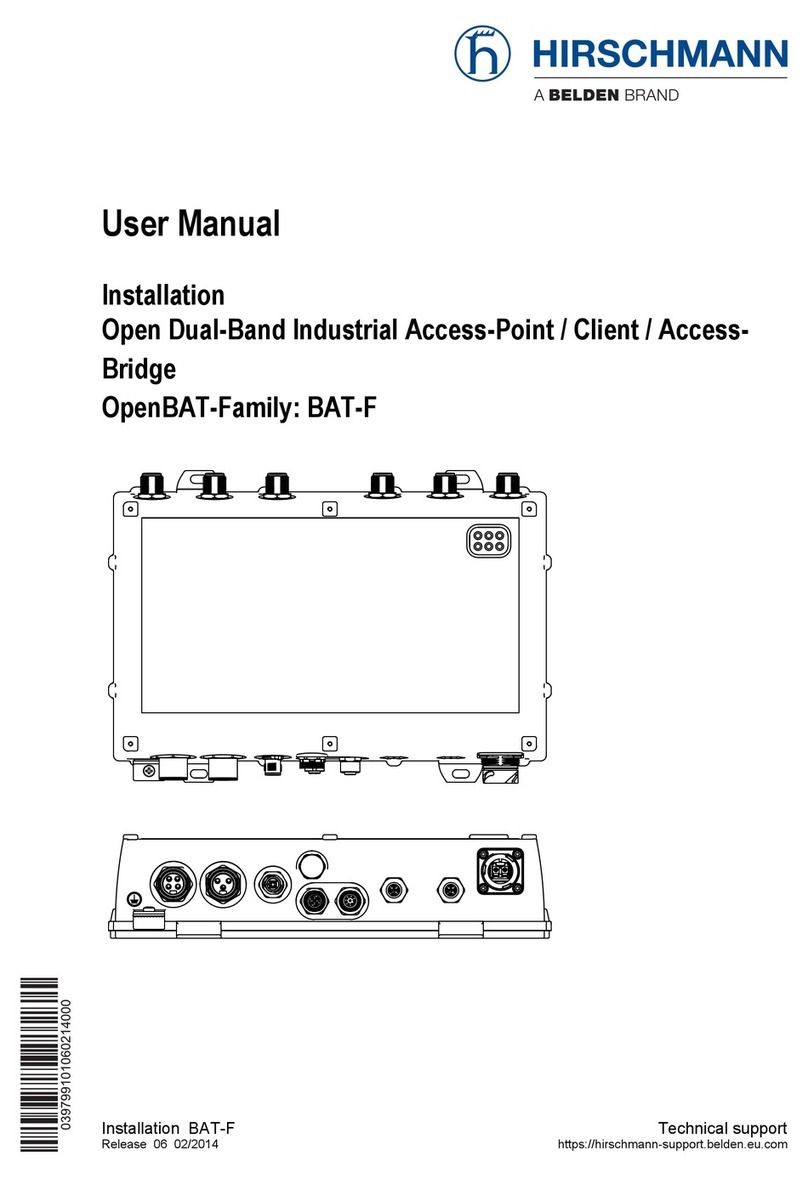
Hirschmann
Hirschmann BAT-F User manual
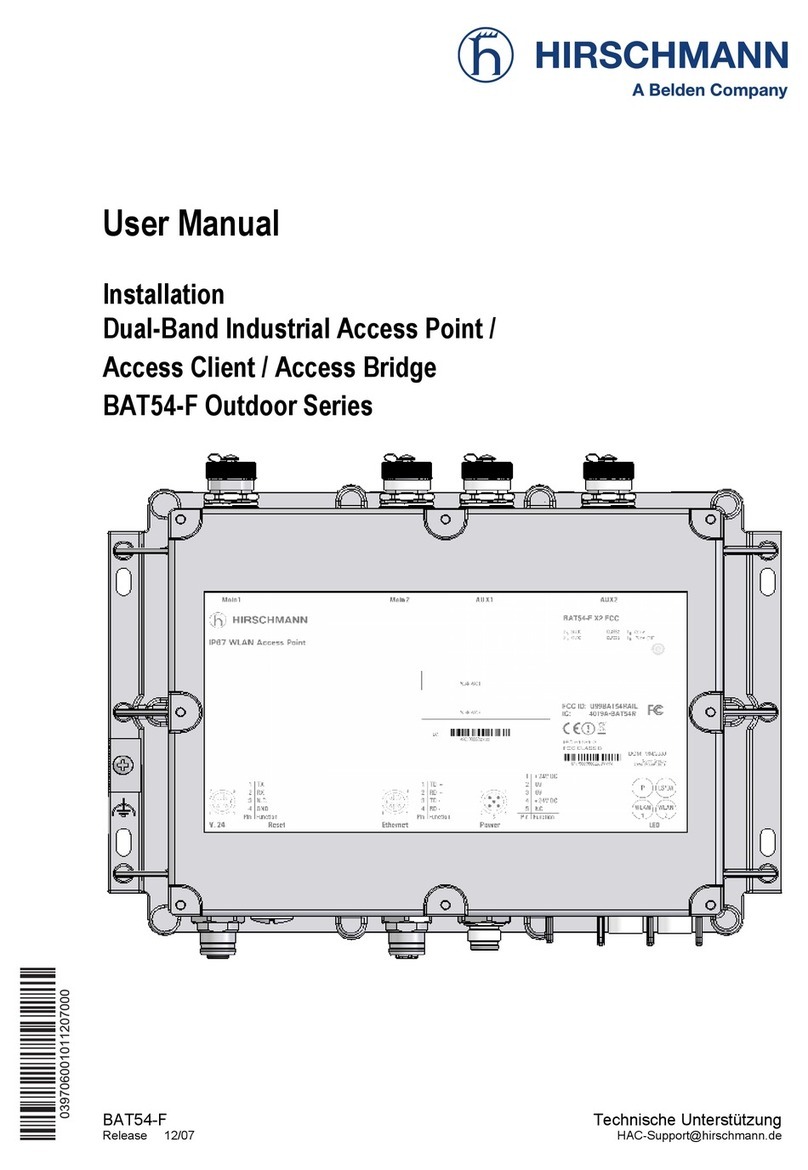
Hirschmann
Hirschmann BAT54-F Series User manual
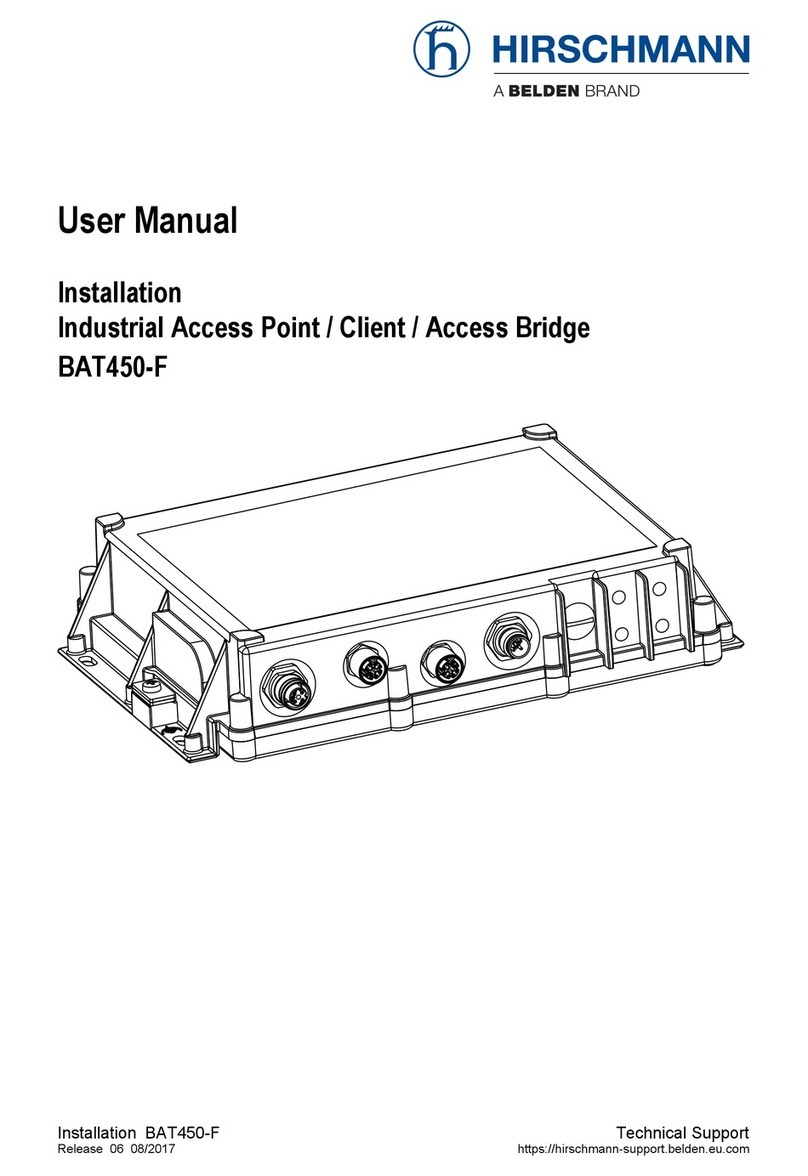
Hirschmann
Hirschmann BAT450-F User manual

Hirschmann
Hirschmann BAT54-Rail User manual

Hirschmann
Hirschmann BAT450-F User manual
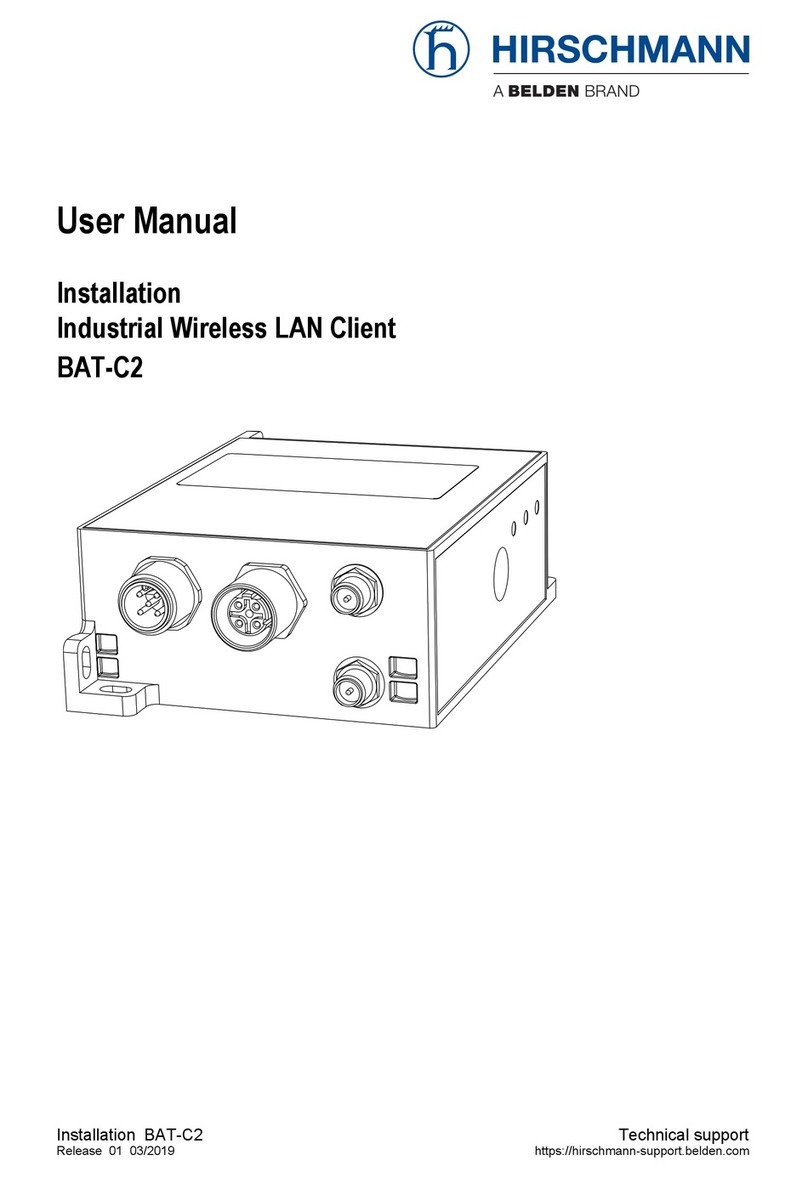
Hirschmann
Hirschmann BAT-C2 User manual
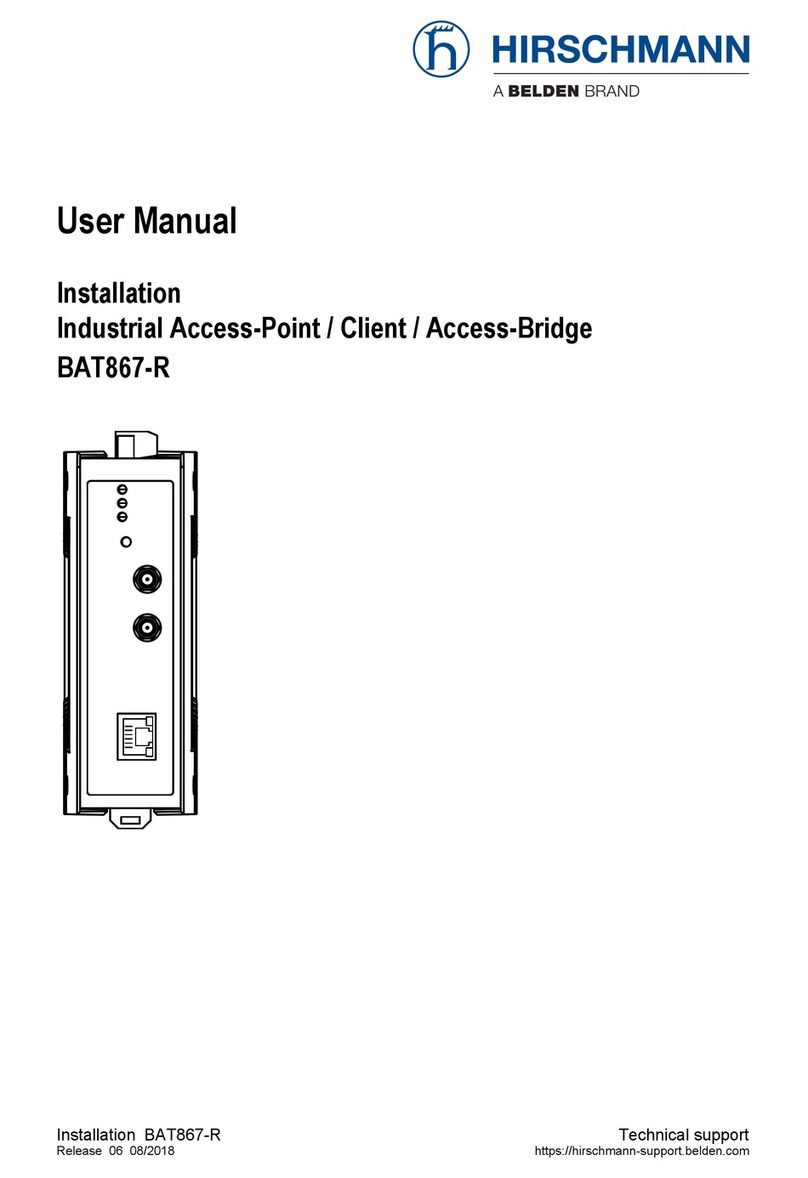
Hirschmann
Hirschmann BAT867-R User manual
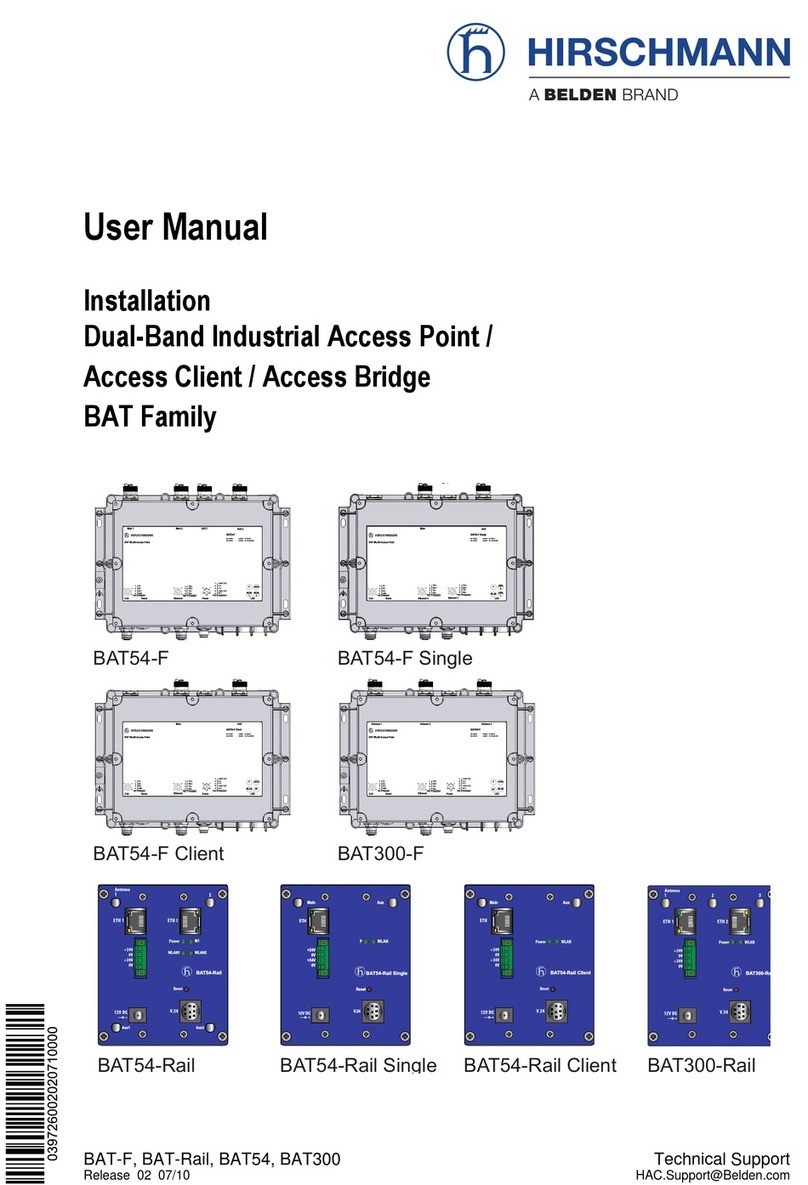
Hirschmann
Hirschmann BAT54-F User manual
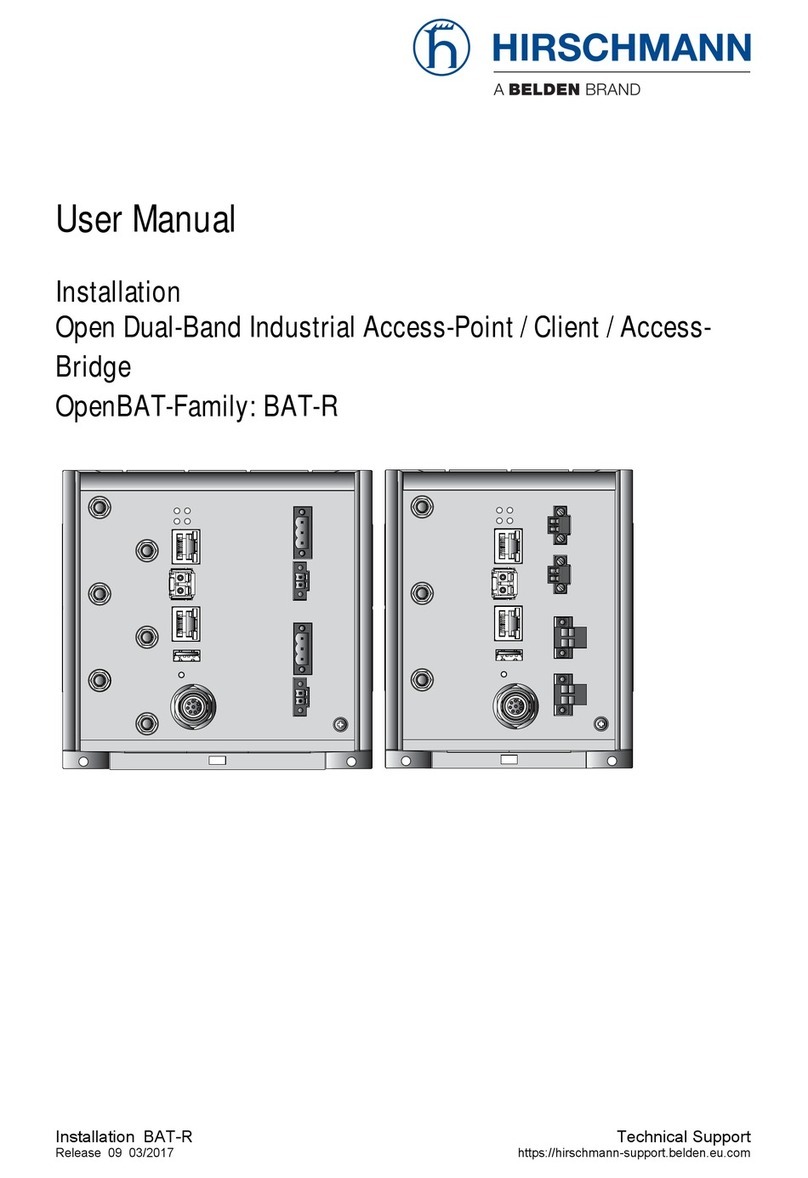
Hirschmann
Hirschmann BAT-R User manual
